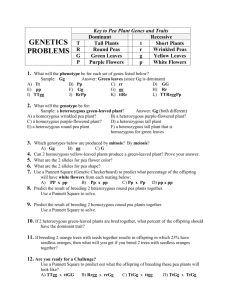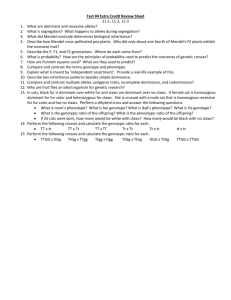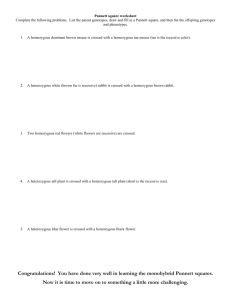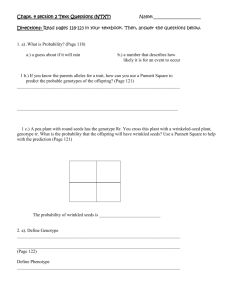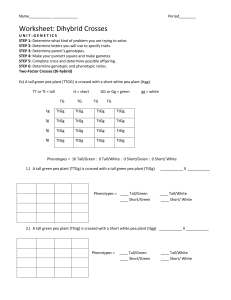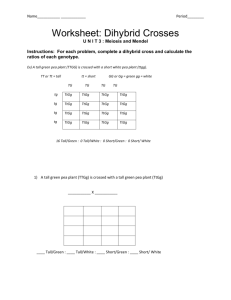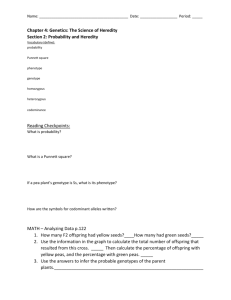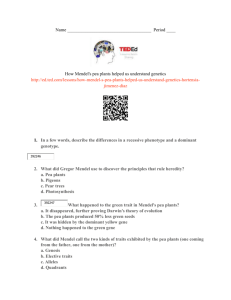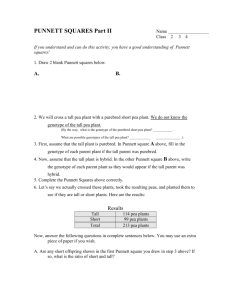attached here
advertisement
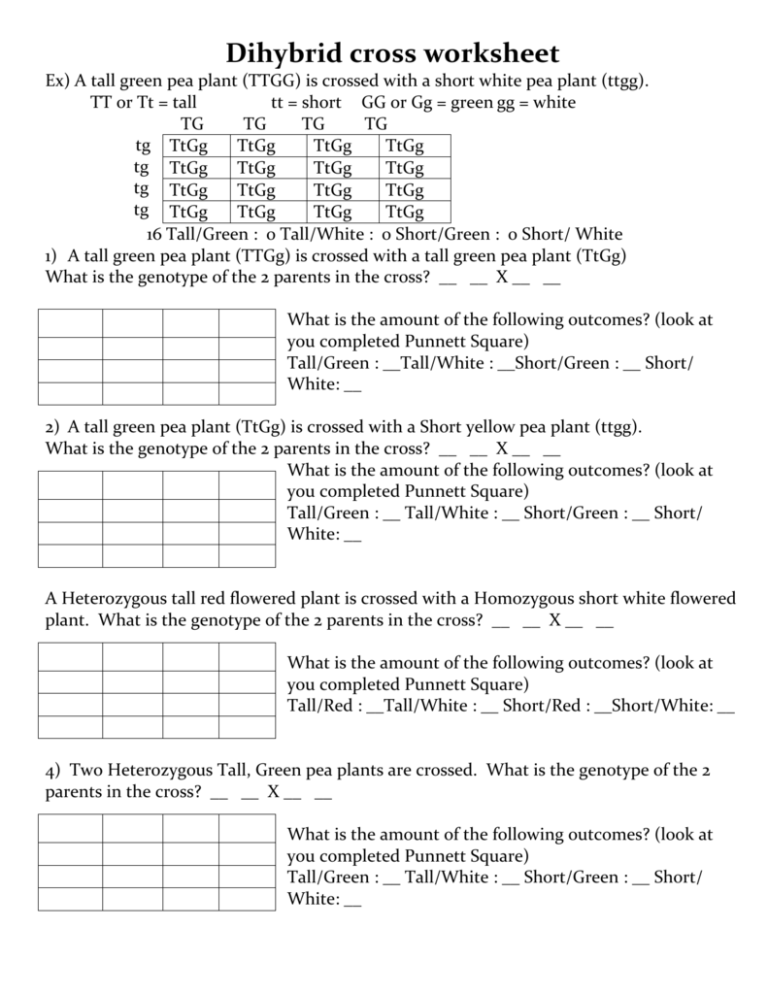
Dihybrid cross worksheet Ex) A tall green pea plant (TTGG) is crossed with a short white pea plant (ttgg). TT or Tt = tall tt = short GG or Gg = green gg = white TG TG TG TG tg TtGg TtGg TtGg TtGg tg TtGg TtGg TtGg TtGg tg TtGg TtGg TtGg TtGg tg TtGg TtGg TtGg TtGg 16 Tall/Green : 0 Tall/White : 0 Short/Green : 0 Short/ White 1) A tall green pea plant (TTGg) is crossed with a tall green pea plant (TtGg) What is the genotype of the 2 parents in the cross? __ __ X __ __ What is the amount of the following outcomes? (look at you completed Punnett Square) Tall/Green : __Tall/White : __Short/Green : __ Short/ White: __ 2) A tall green pea plant (TtGg) is crossed with a Short yellow pea plant (ttgg). What is the genotype of the 2 parents in the cross? __ __ X __ __ What is the amount of the following outcomes? (look at you completed Punnett Square) Tall/Green : __ Tall/White : __ Short/Green : __ Short/ White: __ A Heterozygous tall red flowered plant is crossed with a Homozygous short white flowered plant. What is the genotype of the 2 parents in the cross? __ __ X __ __ What is the amount of the following outcomes? (look at you completed Punnett Square) Tall/Red : __Tall/White : __ Short/Red : __Short/White: __ 4) Two Heterozygous Tall, Green pea plants are crossed. What is the genotype of the 2 parents in the cross? __ __ X __ __ What is the amount of the following outcomes? (look at you completed Punnett Square) Tall/Green : __ Tall/White : __ Short/Green : __ Short/ White: __ Answer the following questions. Use a Punnett square to illustrate your answer as required. 1. Fruit fly traits are represented with the following letters: L = long wings, l = short wings, G = grey body colour, g = black body colour. What is the phenotype of a fly with the genotype LLGg? 2. The organism with the genotype LLGg will produce how many type(s) of gamete(s)? Show how you came to this conclusion. 3. In fruit flies, normal wing shape (V) is dominant to vestigial (v) and grey body colour (G) is dominant to black body colour (g). a. What is the phenotype of a fly whose genotype is VVGG? List the possible gametes of this fly. b. What is the phenotype of a fly whose genotype is VvGg? List the possible gametes of this fly. 4. In horses, the coat color black is dominant (B) over chestnut (b). The trotting gait is dominant (T) over the pacing gait (t). If a homozygous black pacer is mated to a homozygous chestnut, heterozygous trotter, what will be the ratios for genotype and phenotype of the F1 generation? a. What are the phenotypes of the parents? b. Construct a Punnett square for the offspring of the cross in part (a). c. List the genotypes and phenotypes of the offspring of the cross in part (a) along with the genotype and phenotype ratios. 5. In peas, T = tall stems, t = short stems, G = green pods, and g = yellow pods. A cross between a plant that is homozygous for tall stems and heterozygous for pod colour is crossed with a plant with short stems and yellow pod characteristics. Identify the genotypes and phenotypes of the F1 generation. Show your work using the Punnett square. 6. About 70 percent of Americans get a bitter taste from the drug phenylthiocarbamide (PTC), while the other 30 percent do not. The ability to taste this drug (T) is dominant, while the inability to taste the drug is recessive (t). Tongue rolling ability is dominant (R), while the inability to roll the tongue is recessive (r). A tongue-rolling woman who cannot taste PTC has a father who could not roll his tongue but could taste the PTC chemical. She marries a man who can taste PTC but cannot roll his tongue. His mother was unable to taste the chemical. Show the possible children this couple could produce. Use a Punnett square to illustrate your answer. Provide the genotype and phenotype ratios of the offspring. 7. A botanist is trying to create a pea plant that is homozygous for green pod colour and round seed shape. Both of these genes are dominant over yellow pod colour and wrinkled pea shape. The botanist has collected a group of pea plants that produce round peas and green pods. He crosses these plants with a group of plants that have wrinkled peas and yellow pods. a. Show all the possible combinations that may result from this cross and provide the phenotype ratios for the offspring. Explain how the botanist could determine the genotype of the parent with round peas and green pods. b. The botanist determines that phenotype ratio of the offspring is 1 round, green: 1 round, yellow. What was the genotype of the round seed, green pod parent plant?
